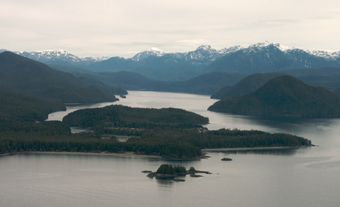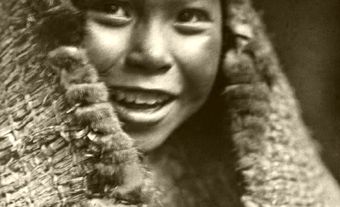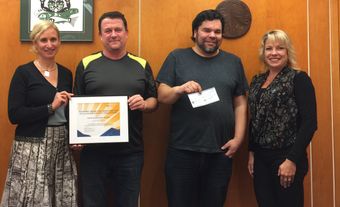The Huu-ay-aht First Nation, located along the west coast of Vancouver Island, British Columbia, numbers 725 registered members, as of December 2021. The Huu-ay-aht are a Nuu-chah-nulth nation and are self-governing under the Maa-nulth Treaty.
Territory and Population
The traditional territories of the Huu-ay-aht are located between Bamfield and Port Alberni. The main community, Ancala (Pachena Bay), is situated on Pachena Beach, at the head of the West Coast Trail, close to the Pacific Rim National Park Reserve.
The site of the ancient capital of the Huu-ay-aht is Kiixʔin. Located on the southeast shore of Barkley Sound, Kiixʔin houses the standing remains of longhouses and other archeological artifacts. The Historic Sites and Monuments Board of Canada designated Kiixʔin a National Historic Site in 1999.
The Huu-ay-aht nation claims that their population was in the thousands before colonization; however, a series of epidemics and conflicts in the late 1700s and early 1800s reduced their population by an estimated 90 per cent. As of December 2021, the total registered population of the Huu-ay-aht is 725, the majority of which (594) live off reserve.
Traditional Life
The Huu-ay-aht hunted and travelled according to the seasons and to the migratory patterns of certain animals. They caught and ate herring, cod, salmon, halibut and other fish, including shellfish. The Huu-ay-aht hunted whales, seals and sea lions, as well as deer, elk and bear. These animals provided food as well as skins and furs for clothing and to make certain tools. Berries and vegetation supplemented their diet.
Society
Huu-ay-aht society was (and still is) composed of various family groups who are governed by a hereditary chief (ha’wiih).These chiefs own the rights to certain ceremonies, songs, stories and territories. Together, they are referred to as the Ha’wiih Council. While the council has great importance in Huu-ay-aht society and culture, it governs in association with elected leaders.
Culture
Historically, the Nuu-chah-nulth have had a strong ceremonial culture, characterised by feasting and entertainment with song, dance, contests and theatricals (see Potlatch). In Huu-ay-aht tradition, sacred members of society known as “wolves” (defined by the nation as “young people with a special talent for ceremonies”) play important roles in certain cultural rituals.
The Nuu-chah-nulth have also been known for their stunning woodwork, including canoes, totem poles, multifamily houses and other products hand-crafted out of fine cedar (see Northwest Coast Indigenous Art).
Language
The Huu-ay-aht speak Nuu-chah-nulth (Nuučaan̓uɫ). More specifically, they speak a dialect known as Barkley. Although the language has suffered at the hands of residential schools and other assimilationist policies, the Huu-ay-aht have worked towards preserving and reviving it. The nation has implemented a program for children called Paawats, which is designed to produce bilingual speakers (see Nuu-chah-nulth: Language and Northwest Coast Language Families).
Religion and Spirituality
The Nuu-chah-nulth belief system centres on a Creator being as well as spirits whose powers can be used to bring peace and fortune. In Huu-ay-aht tradition, natural formations, such as the mountains, seas and forests, are said to contain the spirits of supernatural beings, including Thunderbird. The Nuu-chah-nulth believe that all life forms have a spirit, and should therefore be respected and appreciated. Shamans ensured the spiritual health of the people by practising ancient medicines and healing rituals to cure illness and restore balance to the soul (see Indigenous People: Religion and Spirituality).
Origin Stories
The Huu-ay-aht have different stories to explain the origin of their people. According to one tale, the first ancestors descended from the heavens and founded the current Huu-ay-aht community. Another says that in the beginning there were only spirits and animals who could remove their furs and skins to become Kuu-us ("human"). One day, the animals decided to remain human. These were the first Huu-ay-aht people.
The origin stories explain that the ancestors lived in balance with nature and with animals (referred to as Hišuk ma c̕awak, “all is one”). Nutchkoa was the first man, and Ho-miniki was the first woman; both were deities. The history and traditional stories of the Huu-ay-aht come from their ancestors, and have been continuously passed down to new generations. In the 19th century, carvings of Nutchkoa and Ho-miniki were erected in Kiixʔin to welcome guests. The carvings remain there to this day.
Colonial History
By the 1900s, the increased presence of European settlers on Nuu-chah-nulth lands forced them onto government-created reserves. Assimilationist federal policies — including the Indian Act and residential schools — eroded Nuu-chah-nulth culture and traditional ways of life. Nuu-chah-nulth peoples continue to work towards revitalizing and preserving their language, culture and spirituality.
Rights and Land Claims
In February 2016, the Huu-ay-aht at Bamfield received close to $14 million from the federal government in compensation for its breaches of duty over an unlawful timber licence. This was the first award granted by the Specific Claims Tribunal, established in 2008 (see Indigenous Land Claims).
Contemporary Life
The Huu-ay-aht, along with several other Nuu-chah-nulth nations, have signed the Maa-nulth treaty, which has provided them with self-governance since 1 April 2011. Self-governance gives these nations certain powers over citizenship and lawmaking in their traditional territories. The Huu-ay-aht now manage their own forestry operations as well as other development projects.
The Huu-ay-aht are part of the Nuu-chah-nulth Tribal Council, an association founded in 1958 that provides various services to approximately 9,500 registered members, including child welfare, education, employment training and other socio-economic programs that support health and development.

 Share on Facebook
Share on Facebook Share on X
Share on X Share by Email
Share by Email Share on Google Classroom
Share on Google Classroom







